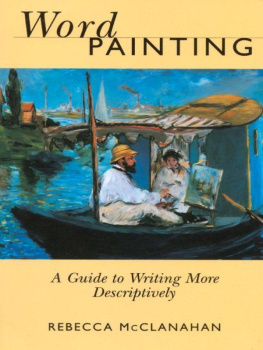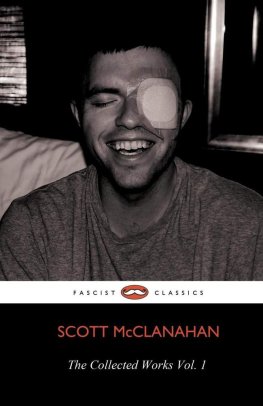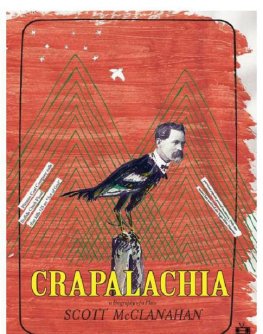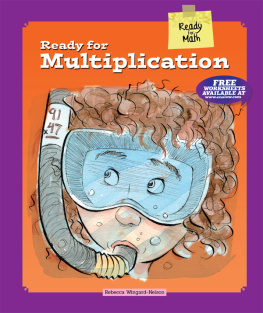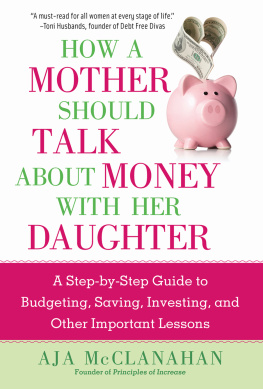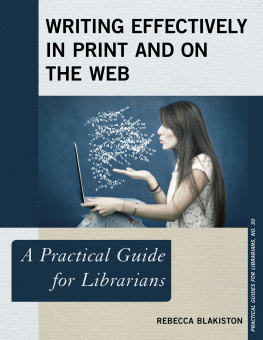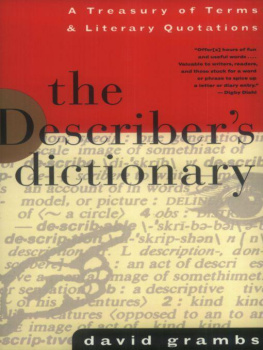Word
PAINTING
A Guide to Wrting More Descriptively
REBECCA McCLANAHAN

WRITERS DIGEST BOOKS
Cincinnati, Ohio
www.writersdigest.com
Rebecca McClanahan has published stories, essays and poems in some of the finest literary journals in the country, including The Kenyon Review, Boulevard, The Georgia Review and The Gettysburg Review. She has published three books of poetry, most recently The Intersection of X and Y, as well as a book of lectures and readings, One Word Deep. In addition, her work has been anthologized in Pushcart Prize XVIII and The Best American Poetry 1998. McClanahan has received the PEN/Syndicated Fiction Award, the J. Howard and Barbara M.J. Wood Prize from Poetry, the Carter Prize for Nonfiction from Shenandoah, and a Governors Award for Excellence in Education. She has taught writing for more than 25 years and currently lives in New York City.
Word Painting: A Guide to Writing More Descriptively. Copyright 1999 by Rebecca McClanahan. Printed and bound in the United States of America. All rights reserved. No part of this book may be reproduced in any form or by any electronic or mechanical means including information storage and retrieval systems without permission in writing from the publisher, except by a reviewer, who may quote brief passages in a review. Published by Writers Digest Books, an imprint of F+W Publications, Inc., 4700 East Galbraith Road, Cincinnati, Ohio 45236. (800) 2890963. First paperback edition 2000.
Other fine Writers Digest Books are available from your local bookstore or direct from the publisher.1
Visit our Web site at www.writersdigest.com.for information on more resources for writers. To receive a free biweekly e-mail newsletter delivering tips and updates about writing and about Writers Digest products, send an e-mail with Subscribe Newsletter in the body of the message to newsletter-request@writersdigest.com, or register directly at our Web site at www.writersdigest.com.
15 14 13 12 11 13 12 11 10 9
Library of Congress has Catalogued Hard Copy Edition as follows:
McClanahan, Rebecca
Word painting: a guide to writing more descriptively / by Rebecca McClanahan.
p. cm.
Includes bibliographical references.
ISBN-13: 978-0-89879-861-6 (hardcover)
ISBN-10: 0-89879-861-2 (hardcover)
ISBN-13: 978-1-58297-025-7 (pbk.: alk. paper)
ISBN-10: 1-58297-025-4 (pbk.: alk. paper)
1. English languageRhetoric. 2. Description (Rhetoric) 3. Creative writing.
I. Title.
PE1427.M38 1999
808.042dc21
98-48002
CIP
Editor: David Borcherding
Production editor: Michelle Howry
Designer: Brian Roeth
Production coordinator: John Peavler
Cover illustration by Edouard Manet (18321883), Claude Monet
and His Wife in the Floating Studio. Neue Pinakothek,
Munich, Germany.

For my father,
who showed me the holiness of detail,
and my mother,
whose all-accepting eye takes in the big picture
ACKNOWLEDGMENTS
Jack Heffron invited me to write this book, then guided my early vision and revision. David Borcherding suggested the books title and advised me on matters of content. My critique groupGail Peck, Diana Pinckney and Dede Wilsonencouraged me along the way. Deno Trakas and Dede Wilson read the completed manuscript and offered sound advice. And my husband, Donald Devet, provided coffee, wine, humor and an attentive ear.
I am grateful.
CONTENTS
INTRODUCTION
When the editors of Writers Digest Books approached me about writing a book on description, I responded the way I respond to all new challenges: Yes. No. Well, Ill think about it. Yes is the child in me, taking my seat on the roller coaster that will whiplash me into the tunnel, up the rickety mountain, around the next exhilarating loop. No is the adult, walking away from the ticket booth: What if the car derails? Whos driving this train, anyway? Does my insurance cover roller coasters? Most writers, I suspect, hear both these voices, often simultaneously, each time they put pen to paper. And I suspect that every book is a duet of opposing voices attempting some semblance of harmony.
Finally, Ill think about it won out. When I thought about it, I realized I was being offered the chance to combine three of my primary passions: writing, reading, and teaching.
As a writer, I know the daily struggle of describing the world around me and the world that dwells only in my head; my recycling bin holds evidence of that struggle. I also know the occasional click of the lock, the satisfaction of words slipping into place, and those few unspoiled seconds when the images in the developing tray coalesce. Yes, theres the barn in all its rotting splendor. Theres the lumpy boy slicking back his cowlick and approaching the long-legged girl.
As a reader, I know which descriptions move me to laughter, terror or unwept tears. I can point to those I wish I had written. Wait, I say, running alongside you with a book in my hand: Listen to this one. Youve got to hear this!
And as a teacher, Ive sat up nightsfor nearly thirty years nowcharting paths to lead my students from there to here, and back again. Its one thing to recognize an effective description; quite another, to guide someone to write one.
Since Word Painting grew from these three passions, it combines direct instruction with personal reflections on the reading and writing process. I set forth basic guidelines for effective description and suggest specific writing exercises. (Some exercises are embedded within the text; others appear at chapter ends.) Along the way, I point out some of my favorite descriptive passages from novels, stories, essays and poems, suggesting ways to use these passages as models for our own writing. And occasionally I take you behind the scenes of this writers ongoing journey to describe what she sees, hears, tastes, smells, touches and imagines.
The book is organized around three main concepts: eye, word and story. After establishing what we mean by description and summarizing the elements of effective description, I move directly into a discussion of the writer as the beholding eye and, in turn, the beholding ear, mouth, nose and hand. Like painters, writers are the receptors of sensations from the real world and the world of the imagination, and effective description demands that we sharpen our instruments of perception. So in the first few chapters, I suggest practical ways to increase our attention to the real world: note-taking, journal-writing, sketching, research, eye-search and I-search. I also discuss techniques for engaging the eye of the imagination and discovering what the inner eye sees.
As I move from eye to word, I consider how to render our subjects clearly, accurately and imaginatively. Though engaging the senses is an important component of word painting, it takes us only so far; we must also describe those sensory images in a fresh way. This involves not only avoiding clichs, but also engaging the eye of the imagination through action-based description and effective figures of speech. In addition, fresh description requires attention to the musical qualities of language. The word sections of the book deal with forming descriptions that are accurate, sensory, imaginative and musical.
Finally, moving from eye and
Next page
